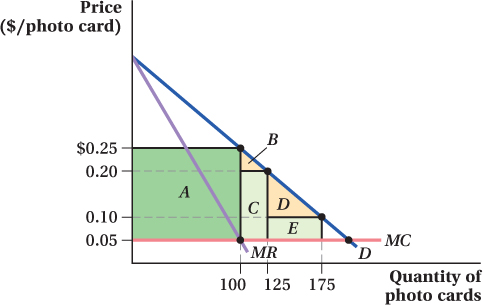
Figure 10.8 Block Pricing
D is the demand curve of an individual consumer of Walmart’s photo cards. Under monopoly pricing, Walmart sells at the point on the demand curve corresponding to the quantity where MR = MC (Q* = 100 photo cards, P* = $0.25 per card). When Walmart can prevent resale, it can use a block pricing strategy instead. It could still sell the first 100 at a price of $0.25 per card, while charging a lower price of $0.20 each for the next 25 photos purchased (for a total quantity of 125 cards) and $0.10 each for the next 50 cards (for a total of 175 cards). Producer surplus increases from area A to A + C to A + C + E, respectively, and consumer surplus increases by area B and areas B + D, respectively.